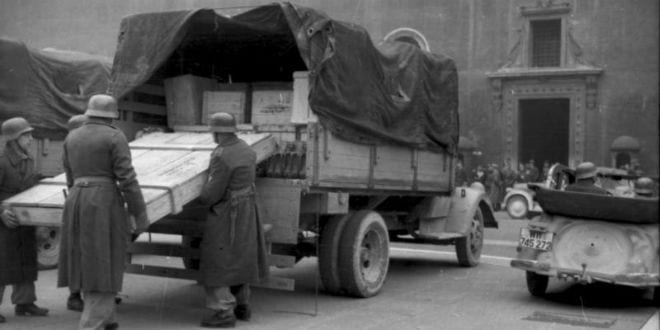
The Times of Israel reported this week that two Israeli art curators have been appointed to a task force responsible for a treasure trove of art found in spring 2012 in a Munich apartment. The collection, discovered in the home of Cornelius Gorlitt, son of Hitler’s most notorious art dealer, is valued at $1.4 billion dollars. It was uncovered during a tax evasion investigation.
Yehudit Shendar, deputy director and senior art curator at Yad Vashem’s museums division, and Shlomit Steinberg, a curator of European art at the Israel Museum, were nominated for the Schwabinger Kunstfund, and although only one name was requested, both were accepted. Project HEART (Holocaust Era Asset Restitution Taskforce), a joint project of the Jewish Agency and the Ministry of Senior Citizens in Israel, submitted the names, in coordination with the Foreign Ministry.
Both women come with an impressive resume in the field. Shendar founded the Holocaust Art Research Center at Yad Vashem, which includes the Archive of Holocaust Art, the Library of Holocaust Art and the Center for Documentation of Nazi-Looted Art. Steinberg curated two important exhibits at the Israel Museum in 2008, “Looking for Owners: Custody, Research, and Restitution of Art Stolen from France during World War II,” and “Orphaned Art: Looted Art from the Holocaust in the Israel Museum,” and has since organized and represented the museum at conferences dealing with art restitution.

“Heirs should have the right to receive back what the Nazis looted, as part of the effort to compensate the Jewish people for the plunder of their property,” Shendar told the Jerusalem Post last year.
Shendar and Steinberg join researchers recommended by the Conference on Jewish Material Claims Against Germany, Sophie Lillie and Agnes Peresztegi, as well as provenance experts from Germany, the US, Austria, Hungary and France. The panel is led by Dr. Ingeborg Berggreen-Merkel.
In order to facilitate the work of this international team, it will be conducted online, allowing members to participate “continuously and simultaneously” from their native countries. The first order of business is to determine the provenance of the artwork, starting with pieces suspected of having been stolen or forcibly sold by the Nazis.
The case only came to light in November 2013, some 18 months after the initial discovery, because of its connection with an ongoing criminal investigation. In all, 1,406 items were found in the apartment. The delayed publication and subsequent lack of transparency has drawn criticism from various parties. The task force made it clear that due to the criminal case, however, much will remain under wraps.
“Many people who would like to see this case go away are dragging their feet,” lawyer Chris Marinello told The Times of Israel last month. Marinello represents the heirs of art dealer Paul Rosenberg, who have registered a claim for a Matisse painting found in Gurlitt’s apartment. “My client is 94 years old and she doesn’t want to be told to have patience,” Marinello said.
Experts have expressed hope that the international makeup of this panel will generate clear guidelines which will help ease the claims process in Germany.
“We hope and believe that this is a turning point on the issue of art in Germany as well as many other countries in eastern Europe. We hope a new standard will be created by the task force in giving the highest priority in returning looted art to survivors and their heirs so justice, although late, can still be done,” said Project HEART head Bobby Brown.




